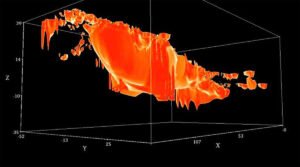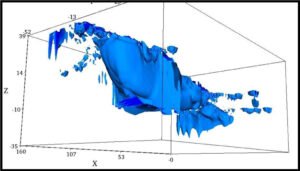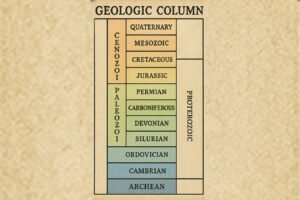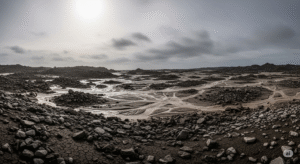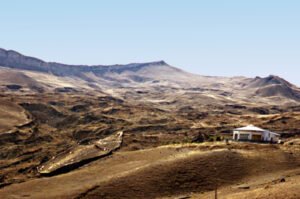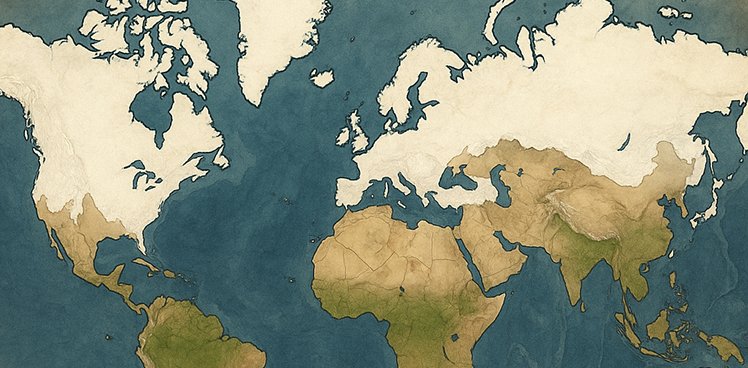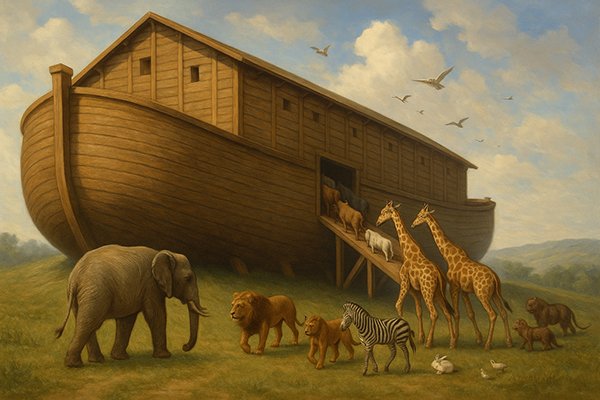The Early Years After the Flood
What Did the Tower of Babel Look Like?
When Ron found the anchor stones in the village in the area of the ark, there was one that has especially intrigued him. Below one of the large crosses is carved a crude picture of a structure which clearly is meant to represent a tower. The crudeness of the drawing indicates that it was not carved at the time the crosses were placed on the stone and he theorized that it was perhaps a representation of the tower of Babel. No ziggurat has ever been found in Turkey so it was rather a surprise to find this.
Although based on theory, Ron concluded that perhaps the Babel tower had been built with this design- instead of steps ascending upward, it had a ramp which spiraled around the structure upward. This would have allowed for much easier transporting of materials as the height increased. It also would have allowed the structure to ascend to a greater height.
As far as we know, this is the only evidence in Turkey which is even suggestive of an ancient tower or ziggurat. Who drew it, we can’t know. When, we also don’t know. But it is the only design capable of reaching the great heights indicated in the Biblical account, and it is interesting that it is found on one of the ancient stones in the village of the Place of Eight. In fact, the stone it is on appears to have been one of the drogue stones. The top portion containing the hole is broken away but the presence of a smooth, rounded section at the top center appears to be the remnant of the hole for the rope.
The Evidence of the Birth of All Languages
To comprehend events of the past, it helps to place ourselves in their “shoes”. For a moment, let’s consider a town where suddenly many, many different languages are being spoken. In the confusion, what would you do?
First of all, everyone would find those who speak their own language. Then, decisions would have to be made about what to do next. If you’ve ever been to a foreign country where you don’t speak the language, you’ll realize that it would be almost impossible to live side by side and continue building, planting, harvesting, etc. with those whom you can’t communicate with. Especially back then when there were no translators.
The first order of business would most likely be to find a separate place to live. You’d need room to raise crops, fields for your flocks and room to begin to build a permanent settlement. Some language groups may set out and settle 25 miles from the original town while others would have to travel 100 or even more before they could find a suitable location.
As time passed, the land nearby would already be taken and new groups would have to travel further and further away to find a suitable location. Some would perhaps be more ambitious and travel much, much further- perhaps 1,000 miles away. But as with all things, there would remain remnants of many, many of the original language groups in the general area.
Eastern Turkey and Armenia- the Origin of All Languages
Today, nowhere else on earth can you find so many different tongues being spoken in such a small area:
“Many ancient races and tribes still inhabit the Caucasus[the mountains above Noah’s Ark which form the northern barrier of the Araxes plain] and the Armenian plateau of eastern Anatolia. As many as fifty different languages and dialects are spoken in this vast and, in parts, inaccessible region.” (LW, p. 137).
“ Strabo informs us (Book XI, 5), that no less than seventy Dialects were spoken in the country, which even then was called the Mountain of Languages” (LH, col. VIII, p. 6,743.)
The further one travels from this area, the fewer languages we find being spoken in an area (with the exception of cases of immigration, such as in the US.) This evidence alone is sufficient to show where the languages began.
What About “Writing”?
The evidence also indicates that the fully formed systems of writing were developed a number of years later and therefore the only written records begin several hundreds of years after the flood. The earliest systems were simply pictures, the easiest way to communicate with almost anyone, even children.
Because of the great diversity of languages, it is most likely that members of families as closely related as cousins found themselves unable to understand their relatives. How would we feel if placed in their position? Would we just separate from those we loved and had been close to? I suspect not. It makes sense to me that some would at least try to perhaps settle in adjacent communities. Unable to verbally communicate, pictures and symbols would provide a crude method of communication, which would be better than nothing.
In time, I’m sure some people learned to speak different languages and communication between some communities was made possible in this manner. But this would have taken time. Today, we can learn foreign languages because there are those who can teach us. These people had to figure it out on their own. But, I’m sure they were quite capable because as we continue, we’ll learn that these people were quite intelligent- much more so than we are today after over 4,000 years of deteriorating since their time.
When true writing systems were discovered, many times they contained bi-lingual inscriptions, or the same material written side by side in two or more languages which indicates the presence of numerous languages in the area.
“In Anatolia, at least, the ethnic and linguistic situation seems to have been exceedingly complex... Although few, if any inscriptions are available for this region before the rise of the Hittite empire, about 1800 ,... there were certainly a great variety of languages and cultures functioning within a comparatively small area. Tablets from the Hittite archives at Boghaz Keui are written in at least 17 different languages, several of which cannot be related to any known linguistic stocks.”. (TC, p. 314.)
And here we have proof that within a few hundred years, there were people capable of translating “at least 17 different languages”!
Ancient Account of the “Confounding” of the Languages
Just as ancient texts have been found with “paganized” accounts of the creation and flood accounts, so have some been found which tell of a time when all men spoke one language. The following passage from “Enmerkar and the Lord of Aratta” is from ancient Sumer, the earliest civilization of southern Mesopotamia near the Persian Gulf:
Once upon a time, the lands Shubur and Hamazi, Many (?)-tongued Sumer, the great land of princeship’s divine laws, Uri, the land having all that is appropriate, The land Martu, resting in security, The whole universe, the people in unison, To Enlil in one tongue gave praise. (SU, p.284-5).
While “Enlil” was the “god” to whom “the whole universe” gave praise, we next learn from a fragment of another ancient Sumerian text, that it was “Enki”, sometimes called “the son of Enlil” (WM, p. 58) who was responsible for the “confounding of the languages”:
Enki,,, Changed the speech in their mouths/ brought(?) Contention into it/ Into the speech of man that (until then) had been one. (PC,p.144.)
Metallurgy Near Babel
We earlier noted Metsamor, perhaps the oldest metallurgy site in the world about 30 + miles above the place of eight where the drogue stones were found.
Referring to the map, note the black dot which says “Babel”- this is the general location of where Ron believes Babel was located. It makes perfect sense that when the group left for Babel, we would expect that they too “set up shop” right away. And the evidence absolutely confirms that this is exactly what occurred. A few miles east of the black dot on the map showing Ron’s site for Babel, on the banks of the Tigris River, is Diyarbakir. And here is found another very ancient metallurgical center!
“Early metalworking in the region of Diyarbakir (`Copperland’)... is indeed suggestive, and needs investigation.”(EC, p. 120).
The extreme importance of this is that, once again, this is by far the earliest instance of metallurgy in the region. It is no coincidence that these earliest sites are found near Noah’s home and near Babel.
Sources of Copper
The early metallurgy throughout the region is very impressive evidence of a technologically advance people who just suddenly appear on the scene. Where did they get their copper? In AA, vol XXVIII, p. 99, article on “Metal Sources in Ancient Anatolia”, all the known ancient copper sources are given on a map. A segment of that map shows that in the immediate area of Ron’s site for Babel are located a large number of copper mines.
This many mines being exploited in one region is good evidence of a very large population being here at one time. The time these early mines were operated could only have been the time of Babel, for after the dispersion from there, the settlements in the area are too small and too scattered to have supported such extensive mining operations.
One Obstacle of the Story of Babel is Eliminated
One concept that is found again and again in the journals and books on Turkish archaeology is that from the earliest times the people there HAD to have had contact with some other peoples from another region because of their use of tin in making bronze. The problem was, you see, that they knew of no source of tin in Turkey. Their conclusion was that other nations were in existence at the same time, which would NOT be the case if the story of Babel is true.
Ron and I wondered if Noah had brought an extremely ample supply of tin on the ark but the problem was that it has been found in such a widespread area and in such large amounts that this wouldn’t have been a feasible explanation. It remained a problem and we had searched all the journals and researched as thoroughly as we could. The question kept arising:
“Regarding the source of the tin used in Anatolia, no one is yet certain from where it came.... the Anatolian tin in antiquity that has so far remained an enigma for us.” (AA, vol. XXVIII, p. 101).
If there was no tin in Turkey, the only plausible explanation would have to be that the people DID indeed have some outside contact with someone from another region- but there wouldn’t BE anyone else if the Biblical account is true, right?
Two 1994 articles by the Oriental Institute of the University of Chicago tell about the recent discovery of a very, very large ancient tin mine at Kestel, about 60 miles north of Tarsus:
“The underground mining system at Kestel measures more than two miles....The mine probably produced about 5,000 tons of ore during it’s1,000 years of operation...”.
And it is in southern central Turkey. Thus, another barrier is removed. The people had tin and they didn’t need to get it anywhere else.
After Babel- Where Did all the People Go?
As we have researched and pored over the archaeological journals, there is one concept which we keep coming across in reference to the earliest sites. It is in regards to the surprising (to them, not to us!) extent of technical knowledge possessed by these peoples.
You must remember that today it is taught that man began as an apelike critter who stumbled across fire after a lightning strike. He then progress to man-like but was extremely primitive, hunting with crude stone implements, eating the flesh off the bones because he had no pottery or utensils. And then one day he suddenly began to plant crops and raise herds. Keep this in mind when you read archaeological reports and completely disregard the dates and areas they assign different sites. What we have to do is concentrate ONLY on the evidence and what it alone reveals.
For example, they have excavated sites in central and eastern Turkey which show absolutely no evidence of evolving from a primitive civilization through the various stages to that of a people who possessed advanced technical knowledge:
“In these centres, up to now, no trace of an older civilization has been discovered....A great problem remains unsolved. How are we to account for the fact that in these regions these [earlier civilizations that we believe ought to have been there] have left no traces whatsoever?” (MA, p. 52).
Different Groups Took Different Technologies with Them
After Babel, there were obviously groups that left the region entirely and some that settled in the immediate and nearby regions. Taking into consideration the fact that the abilities of those within the individual groups would now be limited- some groups would have those experienced in metallurgy, some in pottery, some in art, some in construction, etc.- we must expect to find at least some diversity in the earliest settlements.
And that is exactly what is found. However, this has caused puzzlement to the archaeologists who continue to try to date each site based on the premise that man had uniformly developed through various stages.
One site, Çatal Hüyük, about 150 to 200 miles west of the Babel region, built their homes with no doors- they were entered via ladders. Was this perhaps as protection from the wild animals?
Other sites revealed homes with very thick walls entered through doors. And here we see the diversity that suddenly arose when the people were divided by the language barrier.
Everyone, as Ron says, “has a theory” as to how they think everything ought to be done. And each group now had no choice but to do it the only way they knew how because they no longer had access to that great “pool of knowledge” that man had once possessed when all spoke the same language.
And these homes weren’t primitive. Common building practices included wooden frames with mud-bricks then plastered with lime. Many times they show evidences of having been replastered many, many times, much like we would paint our homes when they begin to flake.
Pottery is Baffling
The pottery, which is used as a basis for dating, has also thrown a wrench into the works, is also baffling because these early sites display much variation in their styles and decoration. At one site, when they reached the earliest level, they found almost no pottery, leading them to believe these people were primitive and used no eating utensils.
But then, they discovered carbonized wooden dishes and vessels along with basketry. The styles of pottery vary considerably from site to site. Some are made without straw while some are made with straw. Some are one color, some are another. Some have beautiful multicolored designs while some have none, or simply geometric designs drawn into the clay without any color at all.
If archaeologists were correct, this would mean that each site represented a different time period in the evolution of mankind. Yet, these same sites present some very obvious similarities which show that they existed during the same time period. For example, almost all except some of the small villages show evidence of metallurgy, which is also quite puzzling to the archaeologists. At one site in southern Turkey the statement is made:
“The perforation of large objects like mace heads presented no difficulty; but it was another matter with the drilling of some of the stone beads, including those of obsidian, which have perforations too fine for a modern steel needle. It is quite uncertain how this was achieved:...” (PH, p. 21).
The bottom-line is this- in the regions extending out from south central Turkey (Ron’s site for Babel) the archaeological evidence reveals very early villages and towns whose earliest level (on virgin soil) presents concrete evidences of people who possessed very advanced technical knowledge:
“...recent, revolutionary finds have left no doubt that it is in the Southern regions of Central Anatolia that Neolithic civilization achieved its greatest progress.” (MA, p. 18).
The Great “Pool” of Knowledge- Divided Up Among the People
Archaeologists have designed their own little system for dating the age of sites that they excavate. These systems are based on the premise of evolution and the idea that man gradually progressed from an ape to a primitive hunter, to a crude agriculturalist, then on to a farmer who domesticated animals, etc. But that is NOT what the evidence shows.
In fact, when simple, factual evidence is removed from the theories that are presented with it as fact, a very clear picture emerges. The evidence shows that when man first appeared in northeastern Turkey, he appeared with very advanced knowledge, as is evidenced by the sophisticated metallurgy of the region as well as the completely developed masonry and construction techniques.
Diversity Among the Earliest Settlements
But for a moment, we must consider another aspect of the confounding of the languages. While the population as a whole possessed a wide variety of knowledge and abilities, when they suddenly were cut off from one another by the language barrier, they would no longer have had access to the great “pool” of pre-flood knowledge. Each language group would only have the knowledge and abilities of those within their own group.
Therefore, we would expect some to excel in metallurgy while others excelled in animal husbandry or crop cultivation. Some groups would have people who were talented artists while others would have those who were knowledgeable in engineering and construction.
From this point on, we would expect more diversity in the early settlements, even those relatively close to one another. Secular archaeologists and paleontologists, not believing the Biblical account but instead believing in evolution, classify these various groups of people who may excel in one aspect and display a total absence of another.
Those who mainly hunted (using spearheads and arrowheads of flint, etc.) but did little or no farming are classified as “Paleolithic” or stone age.
20 miles away another settlement that farmed and had domesticated animals are classified as “neolithic”, thousands of years later than the other group.
One group whose pottery was painted nicer and with more colors than their neighbors down the way whose pottery-maker wasn’t an artist and whose designs were crude were dated maybe 1,000 years apart.
And etc., etc. But in fact, these folks all lived at the same time.
This situation can be distinctly seen in the region around Ron’s site, the area of southeastern Turkey. Some settlements had round houses while others were rectangular. Their pottery varied- some displayed great artistic flair while others were sensible and usable, but not works of art.
No Evidence of Invaders
These early settlements demonstrate some very interesting features. For one, there is no evidence of invaders. It appears that they lived here for a while and then simply disappeared, packing up and leaving.
But certain evidences give some indication where at least some of them went. In all of the early sites have been found strange, grotesque figures of a woman, some standing, some sitting, some with animals, some with children, etc. The indication is that she represents the “mother goddess of fertility”. This concept is represented in the other early religions by the Egyptian Isis, the Assyro-Babylonian Ishtar, the Phoenician Astarte, the Iranian Ashi, the Greek Aphrodite and the Roman Venus, to list a few.
Evolution of Gods and Goddesses
But in time, the concept of a goddess of fertility, be it regarding children, animals or crops, these just listed appear in an organized system of gods and goddesses. This early goddess seen in a figure found at Çatal Hüyük found in Turkey is the original from which the others “evolved” (I hate using that word, but sometimes it is appropriate).
Once some of Noah’s family began to slip from the worship of the true God and fell into paganism, it makes sense that one of their biggest concerns and focal points would be that of fertility. Remember that they started out on an earth devoid of everything- animals, crops and people. Their survival depended upon crops and animals, and they of course wanted a large family.
The more children, the more to help with the work and things that had to be done. And the fact that these figures are found in almost all of the early settlements indicates that “she” was a common “goddess” among the people prior to Babel. The homes and pottery may differ, but the good old “goddess” is always identifiable.
The Mother Goddess Spread Throughout the World
After the early peoples left Turkey, we know they eventually scattered all over the world. But some things can be identified with more precision. For example, this “mother goddess” is found not only in the Mediterranean region, but also in eastern Europe and parts of Spain and France. This photo shows a statue found in Austria. But amazingly, the date given is 30,000 years ago! (LE, p. 150). The next figure comes from Czechoslovakia and has been dubbed “the Venus of Věstonica”. (EB, vol vii, p. 691).
Here we can see the direct influence of those who lived in south central Turkey. Since the archaeological evidence shows that these early settlements weren’t destroyed or conquered by a foreign people, the logical explanation is that at least some of them headed west to Europe, taking their “mother goddesses” with them.
It is the tendency of scholars today to take evidences such as these and view them in light of their own theories and not the Bible. They want to say that, for example, the Hebrews got their flood story from the ancient Babylonians and other such nonsense. The reason they claim this is because some of the Babylonian written account appear to have been written before the Biblical account was written. The first books of the Bible were not written until the time of Moses who wrote them about 900 years after the flood.
With these things in mind, we understand that by the time writing came along, the civilizations doing the writing were completely paganized. Yet, their accounts include certain elements of truth, albeit completely misconstrued. So let’s keep this in mind.
In the great unseen battle, God has given Satan every advantage to try to prove his case. He’s been given the opportunity to corrupt the truth and present his lies. But now is the time that we can look for God’s truth to be vindicated. The pieces are all falling in place. The clearness and accuracy of what Moses wrote shows that the important elements of the beginning and development of life in earth was carefully remembered and passed down the lineage of those loyal to the Creator. Of course, they were aided by the “perfect memory” of God.
Summary of Ron’s Evidence for Babel
All searches must begin with a plan and Ron’s plan was simple- just locate the area where the Euphrates River intersected with the southern edge of the Taurus Mountains in south central Turkey because he had noticed the enormous plain that was in that location.
From there, begin to look for very large “tells” located near the river. His search began as his flight into Diyarbakir started to descend as it came over the mountains. He photographed an extremely large “tell” which was located along the dry riverbed of the Euphrates (it changes it’s course over time as do all rivers.)
As we mentioned earlier, Turkey has a staggering number of archaeological sites (about 40,000), most of which remain unexplored. When Ron arrived and got a taxi to drive them throughout the region, everywhere they looked, they saw this perfectly flat plain was filled with “tells”, “tells” and more “tells”.
Around the city of Diyarbakir is a region of farming, sparsely populated and still politically unstable. Ron knew they had to confine their investigations to daylight hours for safety’s sake. Like some of our farming states, there were few major roads and lots of fields so they were limited in approaching the sites of interest to some degree.
Taking a road from Diyarbakir which twisted around until it was in the general area Ron wanted to go, he saw a “tell” which was much larger than the others they had seen. It wasn’t the one he had seen from the air, but this one he felt was certainly worthy of investigation. Most of the very old traditions about the tower at Babel tell how a portion of it was struck by lightning and fell to the ground. If this was factual, he felt there would be a “tell” which displayed evidence of such.
And this “tell” did have two segments- one that appeared to be structured and relatively symmetrical, like a city. It was much taller than the other “tells” in the area. And the other segment was right next to the first, graduating downward in size away from the main section like a pile of blocks that fell outward and were covered in dirt.
Climbing this “tell”, he found where a small excavation had been (not recently) done which allowed them to see some of the internal structure. Since this was on the uppermost portion of the “tell”, it was either the topmost level of many levels built on the same site, or it was a very ancient site which had very, very high structures within it.
Brick, Burned Thoroughly, for Stone, and Slime for Mortar
The first thing that Ron found was a section of extremely old baked-brick wall. But what was so exciting was the fact that the bricks were 70 cm. X 70 cm (about 28 “ by 28") and a little over 5 ½ inches thick. As far as we have been able to find, the largest baked bricks found to date are about 20" x 20", 8" smaller than these. The mortar between the bricks is black asphalt or tar mixed with what appears to be sand. So far, these things agreed with what we are told about the construction of Babel. This section of structure is angled upward, not straight like a vertical wall. He obtained samples of a portion of a brick, some mortar and some clay from the area for comparison
Artifacts
He also found several artifacts which indicate the time of the occupation of the site in comparison with other sites in the region. He found several “shaped” stone objects which appear to be some sort of tools. One, with a hole in it, is termed a “palette” by archaeologists though we aren’t sure what it was used for. It has a shaped hole through it and Ron believes it was perhaps used for starting fires by twirling a flint or other object in order to get a spark while flammable materials such as twigs or dry grass were placed underneath the hole. A fire was ignited while stray sparks were prevented from flying outward. Just a theory- we haven’t tried it.
Other objects found were made of pottery material and one we think was a shuttle used in weaving. If placed in a little bag attached to a thread, it could have pulled that through the vertical strands.
Another object has the appearance of a small wheel such as have been found in the same general region attached to small carts probably pulled by oxen. Ron’s specimen matches, in color and size, several complete carts found in the same general region (within about a 70 miles radius).
Those features in AA, vol XXXVI, p. 165-171 are all made of a pale, buffish white clay with wheels from 7.5 cm. to 8.5 cm.- Ron’s is made of the same material of a light reddish buff and measures 7.75 cm. Because of the number of these found, it has been suggested that these early people had a belief similar in concept to some found in Voo-doo; that by fashioning small models of objects, they had a certain power over the true object the figurine represented. (EB, vol vii, p. 691).
This may have been true to some degree that we do not understand because we know that the Egyptians believed that after a person was dead that their “spirit” needed certain objects to return to after “flying around”, such as statues of the dead person.
They also believed that a person’s name, written on the wall of their tomb, was insurance against being cast into oblivion. When people wanted to “curse” someone already dead to this sort of doom, they would chisel away their name. They also knocked off the noses of the statues of those deceased because they believed their “spirit” entered the statue through the nose.
So, perhaps these models of carts represented some paganistic belief concerning things related to commerce or farming. However, the wheel(?) also resembles whorls used for spinning.
One author, when writing of these same objects found in the same region, states:
“Spindle-whorls of stone, baked clay and bone and impressions of textiles on pottery are found in many sites... Spindle-whorls are indeed commonplace at ancient sites all over the Near East; and one common type is shaped like a miniature wheel and made of pottery.... The function of these small wheels is not always certain; they have bilateral hubs, giving them the appearance of belonging to model carts. Such carts are known from a number of sites in or near the Early Trans-Caucasian zone, and discs of hubbed form are even more widespread, occurring at sites in [Soviet] Georgia, Armenia, the Nakhichevan region, and eastern Anatolia.... The very number of the discs, however, mitigates against their invariable interpretation as parts of model carts or wagons.... It seems improbable that these people spent so much of their time making toys. Though some of these discs belong to model vehicles, most of them could perfectly well have served as one type, though not the only one, of spindle-whorl.” (PH, p. 74).
What is at question here is whether these model carts were toys or for cultish purposes.
The most important fact we learn here is that these forms are the most widespread in the area that Noah’s family originally lived in. This indicates that this object, whether spindle-whorl or cart wheel, was brought to the Babel area from the original home of Noah’s family. And by “brought” I mean the “knowledge and use of” was brought here, not the actual object.
The Leg of a “Goddess”
Another object he found was a funny-looking longish object, seen in the photo, which we pondered a bit. It looked like a leg, but we weren’t sure. Then, we discovered the archaeological books on excavations in eastern and south central Turkey contained many, many examples of this same object. It is the leg of one of the well-known “mother-goddess” figurines so common to this earliest period. The sketches below, are of similar legs found in Hacilar.(AA, vol. VIII, p. 147). These have been found by the hundreds, not only in Turkey but in every early civilization in some form or another.
IRON
The most important object that he found was a small piece of metal which upon examination is seen to be two flat pieces of metal welded together. And it is iron.
This was his first investigation in the region and for now, we have no conclusions except that this site provides some very interesting evidence that dates it to the earliest time period. The tools are similar to those found in all the early sites throughout the region that are called “Neolithic”. The “mother-goddess” is certainly one of the earliest types of figurines or idols found. But the baked brick is far larger than that found at other sites, even those dated to a much later date.
This indicates construction on a larger scale or people who were used to handling larger objects, such as the 36" sword blade we mentioned earlier that would be almost impossible to hold with one hand by people today. The presence of iron, not even considering the fact that it appears to be welded, would date it, according to secular archaeologist, to over 1,000 to 1,300 years later. This indicates that the knowledge of metallurgy was “advanced”, declining among certain peoples when they were isolated into groups by language barriers. Combined with the evidences of metallurgy near Noah’s home and the Araxes Valley (Ararat Plain), there can be no denial of the technical abilities of these earliest of peoples on the post-flood earth.
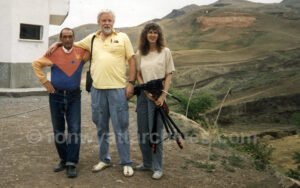
Welcome to the Ron Wyatt Archives. I'm Mary Nell (Ron's wife) and this site will attempt to fully document Ron Wyatt's work and discoveries. This website will be an ongoing project to document his work on all his various discoveries. Please check back often as new things will be added constantly.
| READ MORE |

